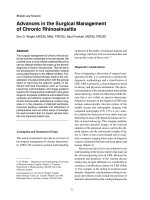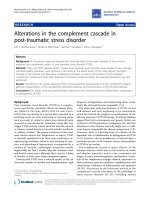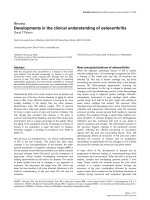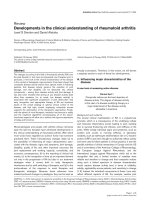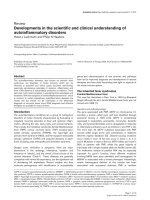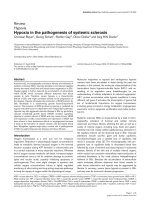Báo cáo y học: " Advances in the genetics and epigenetics of gene regulation and human disease" pps
Bạn đang xem bản rút gọn của tài liệu. Xem và tải ngay bản đầy đủ của tài liệu tại đây (56.67 KB, 3 trang )
Genome Biology 2006, 7:325
comment
reviews
reports
deposited research
interactions
information
refereed research
Meeting report
Advances in the genetics and epigenetics of gene regulation and
human disease
Kristine Kleivi
Addresses: Medical Biotechnology, VTT Technical Research Center of Finland, 20521 Turku, Finland and Department of Genetics, Institute
for Cancer Research, Rikshospitalet-Radiumhospitalet Medical Center, 0310 Oslo, Norway. Email:
Published: 24 August 2006
Genome Biology 2006, 7:325 (doi:10.1186/gb-2006-7-8-325)
The electronic version of this article is the complete one and can be
found online at />© 2006 BioMed Central Ltd
A
report on the Human Genome Organisation (HUGO) 11th
Human Genome Meeting, Helsinki, Finland, 31 May-3 June 2006.
At the recent annual meeting on the human genome in
Helsinki, organized by the Human Genome Organisation
(HUGO), close to 700 scientists gathered to present and
discuss the latest advances in genome research. This report
presents some selected highlights.
Genome variation, gene expression and disease
susceptibility
Through their effects on gene expression, polymorphisms in
the human genome can contribute to phenotypic variation and
disease susceptibility. For many diseases, such as cancer, great
effort is being made to study the sequence variants that con-
tribute to disease susceptibility. The impact of genetic varia-
tion on common diseases was addressed by Kari Stefansson
(deCODE Genetics, Reykjavik, Iceland), who gave an update
on the identified sequence variants that may increase the risk
of developing type 2 diabetes, prostate cancer, myocardial
infarction, stroke and schizophrenia. In the past decades, type
2 diabetes has become a major health problem in the Western
world, as both its incidence and its prevalence have increased
rapidly. Stefansson reported his group’s recent discovery of an
inherited variant of the gene TCF7L7, encoding a protein called
transcription factor 7-like 2 located on chromosome 10, which
is estimated to account for about 20% of the diabetes cases.
They have also showed an association between a common
genetic variant in the microsatellite DG8S737 at chromosome
band 8q24, which may contribute to the development of
prostate cancers in European and African populations.
Single-nucleotide polymorphism (SNP) genotypes correlated
with gene-expression data in breast tumors were presented
by Vessela Kristensen (The Norwegian Radium Hospital,
Oslo, Norway). For genotyping, she and her colleagues
selected sets of genes involved in reactive oxygen species sig-
naling (ROS) and the repair of DNA damage caused by ROS -
that is, pathways that are generally affected by chemotherapy
and radiation therapy. Using various statistical approaches,
the genetic association between SNPs in genes involved in the
ROS pathways and the expression levels of mRNA transcripts
from a panel of breast cancer patients were assessed. Regula-
tory SNPs in the genes EGF, IL1A, MAPK8, XPC, SOD2 and
ALOX12 were associated with alterations in the expression
levels of several transcripts. Kristensen also showed that a set
of SNPs were linked to a cluster of transcripts participating in
the same functional pathway.
Thomas Hudson (McGill University, Montreal, Canada)
described several resources and technologies that are avail-
able to study the impact of genome variation on gene expres-
sion. He and his colleagues systematically studied a subset of
genes whose alleles show large differences in expression in
lymphoblastoid cell lines. These data were integrated with
HapMap data to search for haplotypes associated with
mRNA expression at flanking genes. Hudson described the
discovery of 16 loci harboring a common haplotype affecting
the total expression of a gene, that is, all the alleles of the
gene, and of 17 loci that affected relative allelic expression in
heterozygous samples. To better understand the mecha-
nisms controlling this gene expression, cis-acting polymor-
phisms need to be studied in the human genome in larger
sample sets and tissue panels.
DNA methylation and epigenetic modification
of the genome
Methylation of CpG islands has an important role in control-
ling gene expression during mammalian development, and is
frequently altered in diseases such as cancer. DNA methyla-
tion was extensively discussed in the meeting. For example,
Carmen Sapienza (Temple University Medical School,
Philadelphia, USA) reported that imprinted regions in
humans are historical hotspots of recombination. Together
with specific DNA sequences, epigenetic factors may have an
important influence on the rate of meiotic recombination
and the position of cross-overs. Using in silico and in vitro
analyses, Sapienza’s group have shown a relationship
between increased rates of meiotic recombination and
genomic imprinting. Imprinted regions showed more
linkage disequilibrium, and had a significantly higher
number of small haplotype blocks, than the non-imprinted
regions. Their findings suggest that several factors, including
both specific DNA sequences and epigenetics, are involved in
controlling meiotic recombination in humans.
Nutritional influences during prenatal and early postnatal
development may affect gene expression, and subsequently
the phenotype, through epigenetic gene regulatory mecha-
nisms. Nutrition is important in providing methyl donors for
DNA, and some genes are especially sensitive to nutritional
changes during embryogenesis. Rob Waterland (Baylor
Collage of Medicine, Houston, USA) has used mouse models
to show that some alleles are particularly susceptible to
changes in methylation due to maternal nutrition. For
example, supplementary nutrition can lead to increasing
body weight across several generations of offspring. He and
his colleagues postulate that maternal nutrition before and
during pregnancy may affect the establishment of CpG
methylation and the life-long expression of metastable epi-
alleles (epigenetically modified alleles) in humans.
Whereas the majority of CpG islands in the genome are nor-
mally unmethylated, a sizeable fraction is prone to methyla-
tion in various cell types and pathological conditions.
Christoph Bock (Max Planck Institute for Informatics, Saar-
brücken, Germany) described his group’s work predicting CpG
methylation on the basis of DNA sequence and genomic loca-
tion. Using a bioinformatics approach, they were able to dis-
tinguish CpG islands that are prone to methylation from those
that are not. For example, on chromosome 21, they were able
to predict the CpG island methylation rate with 90% accuracy,
which was later confirmed by in vitro analyses. This study
revealed that the DNA composition of CpG islands, the
sequence, the structure and the number of repeats play an
important role in predisposing CpG islands to DNA methyla-
tion. Furthermore, these features can also be used to predict
the CpG methylation pattern of the whole genome.
Regulatory genomics
Knowledge about transcription factors, their binding speci-
ficities and the assembly of their binding sites to form tissue-
specific enhancer elements is critical for understanding key
regulatory mechanisms of human gene expression. Outi Hal-
likas (University of Helsinki, Finland) aimed to determine the
binding specificities of transcription factors that are involved
in growth control, and to find evolutionarily conserved
enhancer elements that drive organ-specific expression of
genes that regulate a cell’s progression through the cell cycle.
By using a high-throughput method for determining transcrip-
tion factor binding sites, Hallikas reported the binding sites of
the transcription factors GLIs, TCF4 and c-ETS1, which are
involved in different signaling pathways such as those leading
from the signal protein Wnt and the Ras/MAPK intracellular
signaling module. To identify the mammalian enhancer ele-
ments, Hallikas and colleagues have developed a new computa-
tional tool (Enhancer Element Locator; available online
[ and used it to
predict active transcription factor binding sites. Validation of
these in transgenic mice revealed the presence of enhancers
in c-Myc and N-Myc, genes that play a role in growth control
and tumorigenesis.
From the same group, Mikael Björklund presented a
genome-wide RNA interference (RNAi) analysis of genes
that are involved in cell-cycle control and cell-size regulation
in Drosophila. Using flow cytometry, Björklund and col-
leagues analyzed the RNAi-induced loss-of-function of 70%
of the genes in Drosophila, including those conserved in
humans, on cell-cycle progression by flow cytometry. Genes
controlling several cellular processes were identified, includ-
ing cell size, cytokinesis, apoptosis and phases of the cell
cycle. In addition, a translational regulator (eIF-3p66) asso-
ciated with the cyclin/cyclin-dependent kinase pathway was
identified.
The combination of RNAi and gene-expression profiling pro-
vides further insight into gene function and the regulatory
networks controlling expression. Ilaria Piccini (Max Planck
Institute for Molecular Genetics, Berlin, Germany) pre-
sented their genome-wide analysis of transcription factors in
association with gene regulation. Using RNAi, Piccini and
colleagues are knocking down the expression of 200 tran-
scription factors involved in human developmental
processes in a panel of cell lines, and investigating the down-
stream targets of these at the transcriptome level. They have
initially focused on transcription factors encoded by chro-
mosome 21, and as an example, Piccini described the identi-
fication of 72 potential target genes, containing both known
and novel targets, that were dysregulated when expression of
the transcription factor gene BACH1 was silenced.
DNA amplifications in cancer genomes
Gene amplifications are seen in a variety of human cancers,
and are often associated with poor clinical outcome for the
patient. Target genes for amplified regions are often onco-
genes, which may be used as therapeutic, prognostic and
diagnostic targets. Therefore, increasing the knowledge of
DNA copy number amplifications in human neoplasms is
important. This issue was addressed by Samuel Myllykangas
(University of Helsinki, Finland) who presented an extensive
analysis of DNA copy number amplifications in human
325.2 Genome Biology 2006, Volume 7, Issue 8, Article 325 Kleivi />Genome Biology 2006, 7:325
cancers. Using data from published comparative genomic
hybridization studies, they performed an in silico analysis of
DNA copy number changes in approximately 4,500 samples
from over 70 different neoplasms. Computational analysis
identified the different amplification hotspots, which were
spread over large parts of the genome and frequently co-
localized with known fragile sites, cancer genes and virus
integration sites. Amplification of some chromosomal
regions was observed in the majority of the cancers studied,
whereas other amplifications were cancer-site specific. From
the characteristic amplification profiles, Myllykangas
showed that cancers with similar cellular origin and histol-
ogy, such as breast and prostate adenocarcinomas, clustered
together. Their discoveries show the relevance of global
studies on DNA amplifications in human cancers, and
suggest diagnostic and predictive possibilities.
The annual Human Genome Meeting of 2006 was an inspir-
ing meeting, updating us on the latest knowledge in human
genomics. The power of combining high-throughput experi-
mental approaches with genome-wide bioinformatics,
systems biology and data integration was emphasized. Thus,
it was a successful demonstration of strategies that will be
increasingly useful in human genetics in the future.
comment
reviews
reports
deposited research
interactions
information
refereed research
Genome Biology 2006, Volume 7, Issue 8, Article 325 Kleivi 325.3
Genome Biology 2006, 7:325



